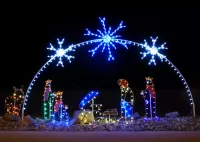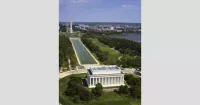The White House, located at 1600 Pennsylvania Avenue NW in Washington, D.C., serves as the official residence and principal workplace of the President of the United States. It has been the presidential residence since John Adams moved there in 1800. The term "White House" is also used as a metonym for the Executive Office of the President.
1901: "The White House" Established as Formal Name
In 1901, President Theodore Roosevelt established "The White House" as its formal name via Executive Order.
1901: Offices relocated to West Wing
In 1901, President Theodore Roosevelt relocated all work offices to the newly constructed West Wing due to crowding in the Executive Mansion.
1902: Expansions and Renovations in Neoclassical Style
In 1902, Theodore Roosevelt hired McKim, Mead & White to carry out expansions and renovations in a neoclassical style, removing the Tiffany screen and all Victorian additions.
1902: Limestone Used in Renovations
Researchers believe limestone from the island was used in the 1902 renovations.
1906: Alice Roosevelt Longworth married in the White House
In 1906, Alice Roosevelt Longworth, daughter of President Theodore Roosevelt, was married in the White House.
1909: West Wing Expanded, First Oval Office Created
In 1909, President William Howard Taft expanded the West Wing and created the first Oval Office.
1913: Jessie Wilson Sayre married in the White House
In 1913, Jessie Wilson Sayre, daughter of President Woodrow Wilson, was married in the White House.
1914: Eleanor Wilson McAdoo married in the White House
In 1914, Eleanor Wilson McAdoo, daughter of President Woodrow Wilson, was married in the White House.
1925: Legislation Allowing Gifts of Furniture and Art
In 1925, Congress enacted legislation allowing the White House to accept gifts of furniture and art for the first time.
1927: Third Floor Converted to Living Quarters
In 1927, the third floor attic was converted to living quarters by augmenting the existing hip roof with long shed dormers.
April 14, 1930: Hoover Moved Back into West Wing
On April 14, 1930, Herbert Hoover and his aides moved back into the West Wing after it was damaged by fire.
1935: Olmsted design for White House grounds
In 1935, the general layout of the White House grounds was based on the design by Frederick Law Olmsted Jr. of the Olmsted Brothers firm, commissioned by President Franklin D. Roosevelt.
1939: Return of Items
In 1939, a Canadian man returned a jewelry box to President Franklin Roosevelt, claiming that his grandfather had taken it from Washington; in the same year, a medicine chest that had belonged to President Madison was returned by the descendants of a Royal Navy officer.
1942: East Wing Added
In 1942, the East Wing, which contains additional office space, was added to the White House.
1946: East Wing Alterations Completed
In 1946, the East Wing alterations were completed, creating additional office space, and Jefferson's colonnades connected the new wings.
1946: Truman Balcony Built
In 1946, the Truman Balcony was built at the center of the southern façade.
1948: House Declared in Imminent Danger of Collapse
By 1948, the White House was declared to be in imminent danger of collapse.
1948: Residence's Structural Failure
By 1948, the residence's load-bearing walls and wood beams were found to be close to failure.
1949: Truman Commissioned Reconstruction
In 1949, President Truman commissioned a reconstruction of the White House and had to live across the street at Blair House.
1951: Truman Lived at Blair House
From 1949 to 1951 President Truman lived across the street at Blair House during the White House reconstruction.
March 27, 1952: Trumans Moved Back into White House
On March 27, 1952, the Trumans moved back into the White House after renovations.
September 1961: White House Declared a Museum
In September 1961, Congress enacted legislation declaring the White House a museum, which prevented the sale of historic or artistic items.
1961: Extensive Redecoration Directed by Jacqueline Kennedy
In 1961, Jacqueline Kennedy, wife of President John F. Kennedy, directed a very extensive and historic redecoration of the White House.
1961: Wallpaper Installed in Diplomatic Reception Room
In 1961, Mrs. Kennedy installed an antique "Vue de l'Amérique Nord" wallpaper designed by Zuber & Cie in 1834 in the Diplomatic Reception Room.
1962: Televised Tour of White House Restoration
In 1962, Kennedy showed her restoration of the White House to the public in a televised tour.
1962: Link Suggested Between White House and French House
In 1962, the first official White House guide suggested a link between Hoban's design for the South Portico and Château de Rastignac.
1967: Luci Johnson married in the White House
In 1967, Luci Johnson, daughter of President Lyndon B. Johnson, was married in the White House.
1969: Pat Nixon Refurbished Green Room, Blue Room, and Red Room
In 1969, First Lady Pat Nixon refurbished the Green Room, Blue Room, and Red Room, working with Clement Conger.
1971: Tricia Nixon Cox married in the White House
In 1971, Tricia Nixon Cox, daughter of President Richard Nixon, was married in the White House.
February 1974: Stolen helicopter lands on White House grounds
In February 1974, a stolen U.S. Army helicopter landed without authorization on the White House grounds.
1974: End of Nixon Administration
The Nixon Administration ended in 1974. During this time, First Lady Pat Nixon refurbished the Green Room, Blue Room, and Red Room.
1977: First Lady's Office Formally Called "Office of the First Lady"
In 1977, Rosalynn Carter was the first to place her personal office in the East Wing and to formally call it the "Office of the First Lady".
1988: House Accredited as a Museum
In 1988, the White House was accredited as a museum.
1994: Plane crashes on White House grounds
In 1994, a stolen light plane flown by Frank Eugene Corder crashed on White House grounds, instantly killing him.
April 19, 1995: Oklahoma City bombing
On April 19, 1995, the Oklahoma City bombing prompted increased security measures at the White House, leading to the closure of Pennsylvania Avenue to vehicular traffic.
May 20, 1995: Pennsylvania Avenue closed to traffic
On May 20, 1995, as a response to the Oklahoma City bombing of April 19, 1995, the United States Secret Service closed off Pennsylvania Avenue to vehicular traffic in front of the White House.
1999: Old Executive Office Building Renamed
The Old Executive Office Building was renamed the Eisenhower Executive Office Building in 1999.
September 11, 2001: Increased security measures after September 11 attacks
After the September 11, 2001, attacks, Pennsylvania Avenue's closure to traffic in front of the White House was made permanent, and E Street was closed between the South Portico and the Ellipse.
September 2003: White House tours resume on a limited basis
In September 2003, White House tours resumed on a limited basis for groups making prior arrangements through Congressional representatives or embassies, with background checks, after being suspended due to the September 11 attacks.
2003: Solar Thermal Heaters Reinstalled
In 2003, the Bush administration reinstalled solar thermal heaters to heat water for landscape maintenance personnel and for the presidential pool and spa.
May 12, 2005: White House evacuated due to unauthorized aircraft
On May 12, 2005, the White House was evacuated after an unauthorized aircraft approached the grounds. The pilot, a student, was forced to land and was found to have accidentally breached the airspace.
2005: NASAMS used to patrol airspace
During the 2005 presidential inauguration, NASAMS (Norwegian Advanced Surface-to-Air Missile System) units were used to patrol the airspace over Washington, D.C. The same units have since been used to protect the president and all airspace around the White House.
June 23, 2006: American Elm tree falls
On June 23, 2006, a century-old American Elm tree on the north side of the White House fell during a storm amid intense flooding.
2007: Renovations of the Press Briefing Room
In 2007, renovations of the press briefing room were completed, adding fiber optic cables and LCD screens for the display of charts and graphs.
2007: Ranked Second on AIA List
In 2007, the White House was ranked second on the American Institute of Architects list of America's Favorite Architecture.
2008: Jenna Bush Hager married in the White House
In 2008, Jenna Bush Hager, daughter of President George W. Bush, was married in the White House.
September 2010: Project on the West Wing Began
In September 2010, a two-year project began on the West Wing, creating a multistory underground structure.
November 2013: White House reopens to the public
In November 2013, the White House reopened to the public after being suspended for most of 2013 due to budget constraints.
2013: Solar Panels Installed on White House Roof
In 2013, President Barack Obama had a set of solar panels installed on the roof of the White House, marking the first time solar power was used for the president's living quarters.
January 27, 2015: Drone crashes on White House grounds
On January 27, 2015, an intoxicated man lost control of a quadcopter drone which crashed on the southeast side of White House grounds, prompting a temporary lockdown.
2017: Removal of Jackson Magnolia
In 2017, the Jackson Magnolia, planted by Andrew Jackson, had become too weak to stand on its own and was removed and replaced with one of its offspring.
June 2023: Fighter jets intercept aircraft near White House
In June 2023, fighter jets intercepted a light aircraft that violated Washington DC airspace near the White House, before it crashed in Virginia, resulting in the death of all occupants.
2024: Equivalent Cost of Original Construction
The reported cost of the initial construction of the White House was $232,371.83, which is equivalent to $4,305,000 in 2024.
2024: Renovation Cost in Current Dollars
The total cost of the White House renovations was about $5.7 million, which is $69 million in 2024.
September 2025: Ballroom Expansion Began
Work on a ballroom expansion began in September 2025, including demolition of part of the East Wing facade to accommodate the ballroom.
2025: Flagpole installation
In 2025, President Donald Trump oversaw the installation of an 88-foot flagpole on each lawn and a patio to replace the grass lawn of the Rose Garden.
Mentioned in this timeline

Donald John Trump is an American politician media personality and...

Melania Trump a Slovenian-American former model has served as First...

Barack Obama the th U S President - was the...

Christmas is an annual festival celebrated on December th commemorating...

Washington D C is the capital city and federal district...

Valentine's Day observed annually on February th began as a...
Trending
Jaden McDaniels is an American professional basketball player currently playing for the Minnesota Timberwolves in the NBA He played college...

9 months ago Dire Wolf's potential return clashes with Trump's endangered species policy; de-extinction questioned.

28 days ago Trump Pardons Gobble and Waddle: A Thanksgiving Tradition Continues with Presidential Humor.

1 month ago Peyton Watson's Opportunity: Millions on Nuggets Roster and Denver Breakout Potential.
7 months ago HBO's 'Mountainhead' skewers tech elite in a satisfying end-of-world satire.
1 month ago HBO Max Offers Huge Black Friday Discount: One Year for Just $36!
Popular

Ben Shapiro is a prominent American conservative political commentator media...

XXXTentacion born Jahseh Dwayne Ricardo Onfroy was a controversial yet...

Candace Owens is an American conservative political commentator and author...

William Franklin Graham III commonly known as Franklin Graham is...
The Kennedy Center Honors are annual awards recognizing individuals and...

Tucker Carlson is an American conservative political commentator known for...
